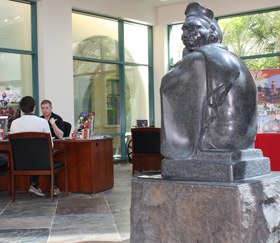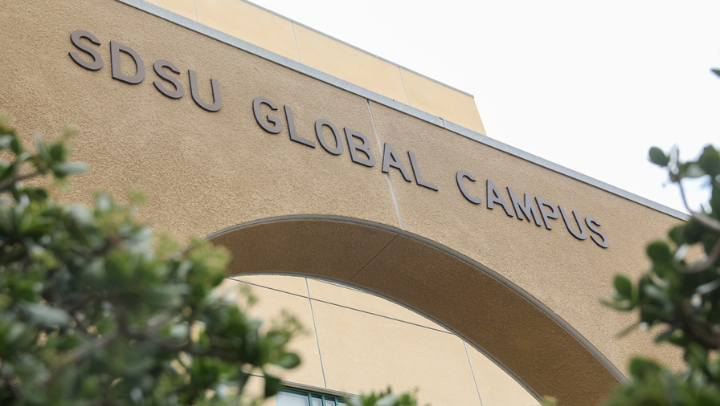The Mystery of 'Monty'
May 2 marks the 75th Anniversary of Donal Hord's iconic sculpture.

At this month’s Monty Awards gala, eleven of San Diego State University’s most accomplished alumni and friends will be honored for their achievements with miniature replicas of what is arguably the university’s most iconic symbol: the statue that sculptor Donal Hord presented to SDSU during a Founder’s Day celebration in 1937. May 2 marks the 75th anniversary of the dedication of the piece Hord called “Aztec.”

So why does everyone else know the statue as “Monty?”
"It's one of the big mysteries (on campus) and I wish I had a solution to this one,” says SDSU Anthropology Department Chairman Seth Mallios. He writes about the statue in his forthcoming book, “Hail Montezuma: The Hidden Treasures of San Diego State.”
“I've heard it called 'The Aztec,' 'Aztec,' and 'Montezuma,'” he says. “Where it gets especially confusing is there is a plaque that's screwed into the base of the statue that says in quotes, 'Montezuma,' even though everything I've seen shows that Hord referred to it as 'Aztec' or 'The Aztec.'”
High Praise
The stone base was presented as a gift to the school by the class of 1937. Mallios, who has thoroughly researched the statue, can only speculate as to why the graduating students’ dedication plaque bears a different name.
“I don't know if they thought it should be named something or they thought it was called something, but there is that discrepancy," he says. Of course, with the Montezuma plaque firmly affixed to its base and with nicknames being all the rage in those days, the regal Aztec statue soon became known to everyone simply as “Monty.”
But that wasn’t the case in the art world where Hord’s Aztec was hailed as a modernist masterpiece. At the statue’s dedication, Stanton MacDonald-Wright, a noted artist and at the time the director of the Southern California division of the federal Works Project Administration which backed Hord’s work, spoke glowingly of the sculpture.
“Mr. Hord has chiseled the finest stone figure ever to have been done by an American,” he is reported to have said.
A treasure
In fact, Hord’s Aztec was so admired that in 1941 it was removed from the northeast corner of the quad and shipped to New York for an exhibition at the Museum of Modern Art. Today, artists still appreciate the statue.
SDSU professor emeritus Jess Dominguez taught sculpture in the art department. His work on campus includes the War Memorial and the recently dedicated bust of legendary SDSU football coach, Don Coryell.
"It's a very strong, well done piece like all of his work,” Dominguez says of Hord’s Aztec. "When somebody asks about stone (as a sculpture medium) I say, 'Go look at that.'”
Dominguez appreciates the fact that Hord chose to fashion his Aztec from diorite, an extremely hard stone material for sculpting by hand. He admires the work the artist and his assistant put in over the 14 months it took to carve the piece.
"It's hard because you hit it with a chisel and it just dulls the chisel, so it has to be a lot of little hits with a lot of little points,” the professor explains. “So that's why it's so difficult and he did such a wonderful job.
“I recommend people look at it and look what he did with the figure. Look at the toes. They're stylized and changed. He’s in a very passive pose — it’s a peaceful piece. He doesn't have knives or daggers or war clubs. He's not threatening to anybody or anything. I think it's nice."
SDSU Professor Emeritus Jess Dominguez works on a sculpture.
“There's a lot to be learned from what Hord did. I think it's very iconic, very graphic. When you see it, everybody knows Monty and they know that's our guy. I think he's a more respectful and classier symbol for State. It’s a treasure."
Valuable and vulnerable
According to the 1937 Del Sudoeste yearbook, at the time it was dedicated, the statue had an approximate value of $6,000. Its worth today is anybody’s guess.
“I don't know what the value is on it, but it's worth a lot of money," Dominguez speculates. "It would be hard to find out what it's worth."
That’s one reason why he’s happy that after decades of public display on the open campus, the statue was finally moved indoors in 2002 to the Prospective Student Center. There, it is less vulnerable to the elements or to vandals.
"I think it's a good place,” says Dominguez. “For many years I was afraid that it was out there all by its self and I thought all it would take is one hammer blow and that thing would be destroyed."
There are those who argue that Hord intended for his statue to always be displayed outdoors - that it is best appreciated in natural light in a natural environment. But Mallios agrees that placing the sculpture inside the glass pyramid of the Prospective Student Center is a good compromise.
A 1937 photo of the Aztec statue in its original location inside the old quad.
“This is the most important sculpture on campus and there have been pranks on it before that haven't been respectful,” he says. “I do think this is a statue that needs to have some degree of protection and so I love the fact that it's enclosed, but enclosed in an area that gets natural light, following the views, the ideas, the perspective of the creator of this masterpiece.”
Symbolism
In order to allow freer public access to Monty, in 2009 the SDSU Alumni Association installed a larger concrete replica in the rotunda of the new Parma Payne Goodall Alumni Center. It gazes east across campus toward the original.
"Because I spend so much time trying to explain how this place is symbolic, I do think it's worth emphasizing that you have Hord's Aztec in the Prospective Student Center and it's facing the alumni center, says Mallios. “It represents the start and the end of the collegiate experience in terms of coming to school as a prospective student and then graduating. Our space here is symbolic and we want these things to be explained because far too many people just walk past things every day."
At the 1937 Founders Day ceremony, then-president emeritus Hardy proclaimed of the statue: “Today, the traditions of the college will center around the creation of this man, the Aztec." Seventy-five years later, Hardy’s words remain prophetic.
From the alumni center to website reproductions to tiny replicas handed out as awards, the traditions of San Diego State are still bound to a singular image of strength and serenity now recognized by generations. And whether this statue was originally named “Aztec” or officially labeled “Montezuma,” it will likely always be affectionately known as “Monty.”



